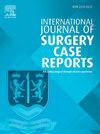Adenoid cystic carcinoma of the tongue: A case study highlighting surgical management of an exceptionally rare entity
IF 0.6
Q4 SURGERY
引用次数: 0
Abstract
Background
Adenoid cystic carcinoma (ACC) is a rare malignant tumor that accounts for <1 % of head and neck malignancies, with an estimated involvement of the tongue at approximately 3 %.
Case presentation
This report presents a case of a 42-year-old male with no significant history of tobacco or alcohol use, who developed a painless, progressively enlarging mass on the ventral surface of his tongue over the course of eight months. Initial surgical resection confirmed the diagnosis of ACC, which necessitated a right hemiglossectomy followed by radiotherapy to address potential residual disease.
Discussion
ACC of the tongue presents unique clinical challenges due to its rarity and aggressive nature. The lack of traditional risk factors indicates that ACC can arise in low-risk populations, underscoring the necessity for heightened awareness among healthcare professionals to facilitate early detection. Surgical resection remains the standard treatment; however, achieving negative margins is challenging due to the tumor's infiltrative characteristics, which can lead to local recurrence. Histologically, ACC is classified as a biphasic neoplasm often associated with perineural invasion, and high-grade transformation increases the risk of metastasis. Postoperative radiotherapy is recommended to reduce the risk of recurrence, particularly in cases exhibiting unfavorable histological features. A personalized treatment strategy that takes into account tumor characteristics and patient-specific factors is essential for effective management.
Conclusion
This case underscores the importance of vigilance in identifying symptoms of ACC of the tongue, even in low-risk individuals. It advocates for a multidisciplinary approach that includes surgical intervention and adjuvant radiotherapy to achieve optimal outcomes.
背景:腺样囊性癌(ACC腺样囊性癌(ACC)是一种罕见的恶性肿瘤,多见于病例:本报告介绍了一例 42 岁男性病例,患者无明显烟酒史,8 个月来舌头腹面出现无痛、逐渐增大的肿块。最初的手术切除确诊为 ACC,因此必须进行右半舌切除术,然后进行放射治疗以解决潜在的残留疾病:讨论:舌ACC因其罕见性和侵袭性,给临床带来了独特的挑战。缺乏传统的风险因素表明,ACC 可能发生在低风险人群中,这就强调了提高医护人员的认识以促进早期发现的必要性。手术切除仍然是标准的治疗方法;然而,由于肿瘤的浸润性特点,实现阴性边缘具有挑战性,这可能会导致局部复发。在组织学上,ACC 被归类为双相肿瘤,通常伴有神经周围浸润,高级别转化会增加转移风险。建议采用术后放疗来降低复发风险,尤其是对于组织学特征不佳的病例。考虑到肿瘤特征和患者特异性因素的个性化治疗策略对于有效治疗至关重要:本病例强调,即使是低风险患者,也必须提高警惕,识别舌 ACC 的症状。该病例主张采用多学科方法,包括手术干预和辅助放疗,以达到最佳治疗效果。
本文章由计算机程序翻译,如有差异,请以英文原文为准。
求助全文
约1分钟内获得全文
求助全文
来源期刊
CiteScore
1.10
自引率
0.00%
发文量
1116
审稿时长
46 days

 求助内容:
求助内容: 应助结果提醒方式:
应助结果提醒方式:


